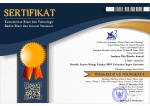Abstract
Rambusa (Passiflora foetida L.) (Passifloraceae) is a plant that contains larvicide bioactive compounds, namely acetogenin, polyphenols, ethanol, citric acid, alkaloids, tannins, coumarin, procyanidin, triterpenoids, flavonoids, and saponins (Kaerati dkk, 2015). The purpose of this research was to determine the effectiveness of rambusa (Passiflora foetida L.) plant extract as liquid mosquito repellent against the development vector of malaria mosquitoes (Anopheles sp.) and to determine the most effective concentration to produce liquid scale insecticide LAB products.This research was conducted at LAB. Undana Bio-Science Kupang uses a simple experimental RAL method with 4 treatments and 3 replications to obtain 15 experimental units. Variation in concentration of 0% (negative / positive control) 10%, 20%, 40% of 1000 ppm. Data analysis using BSLT probit analysis to determine the LC50 value. The results showed that the administration of rambusa (Passiflora foetida L.) fruit extract effectively killed larva at concentrations 100 ppm by 23,3% from 10 larva, concentration of 200 ppm at 65,7%, from 10 larva, concentration of 400 ppm at 100% of 10 larva. The results of probit analysis obtained a relationship curve log concentration to the probit value with a linear curve equation y = 8,4x – 13,79. The LC50 value obtained was 173,78 ppm with a significance value of 0,212> 0,05 so that the concentration of 173,78 ppm was most effectively used as a liquid insecticide on the LAB scale.
Keywords
larvicide; malaria mosquitoes; passiflora; toksisitas; vector







